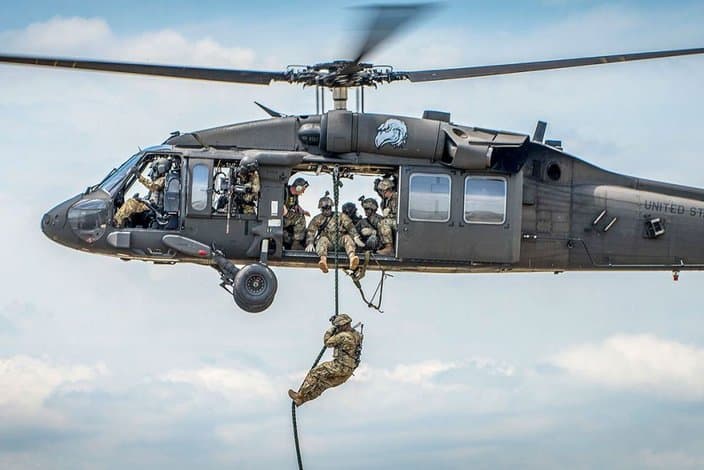By Dan Lamothe
 The U.S. Army will unveil details about its largest reorganization in 45 years Friday, senior service officials said, as they create a new organization in an attempt to adapt more quickly to technology and address expensive failures in weapons acquisitions. Army Futures Command is being established in part to address concerns about the more than $32 billion the Army has spent since 1995 on programs that it canceled early with little to nothing to show for them. The new power center will be on par with other influential Army organizations, such as Training and Doctrine Command and Forces Command, and commanded by a four-star general. The move marks the largest reorganization at Army headquarters since 1973, when the Army sought to reorient itself after the Vietnam War and created both Training and Doctrine Command and Forces Command. Their commanders have often gone on to hold even more powerful jobs, including chairman of the Joint Chiefs of Staff and chief of staff of the Army.
The U.S. Army will unveil details about its largest reorganization in 45 years Friday, senior service officials said, as they create a new organization in an attempt to adapt more quickly to technology and address expensive failures in weapons acquisitions. Army Futures Command is being established in part to address concerns about the more than $32 billion the Army has spent since 1995 on programs that it canceled early with little to nothing to show for them. The new power center will be on par with other influential Army organizations, such as Training and Doctrine Command and Forces Command, and commanded by a four-star general. The move marks the largest reorganization at Army headquarters since 1973, when the Army sought to reorient itself after the Vietnam War and created both Training and Doctrine Command and Forces Command. Their commanders have often gone on to hold even more powerful jobs, including chairman of the Joint Chiefs of Staff and chief of staff of the Army.
Discussions about Futures Command began to take shape about two years ago, and gained steam after Defense Secretary Jim Mattis released a national defense strategy in January that labeled “near-peer” competitors Russia and China as the top threats to the United States, said Army Under Secretary Ryan D. McCarthy.
McCarthy and a senior officer, Lt. Gen. Eric J. Wesley of the Army Capabilities Integration Center, recently met with state and local officials in the five cities the Army selected as finalists: Austin, Tex.; Boston; Minneapolis; Philadelphia and Raleigh, N.C.
McCarthy said the Army wanted to be near people with expertise in science and technology, especially systems engineering and software development. It also valued locations with robust small-business growth and strong support from local officials.
“You almost need to be smashing into people in innovation,” he said. “You have to have the engagement of countless repetitions of people to help look at ideas, and you get into these wars of ideas, and you get better outcomes because it sharpens the rigor and helps garner better perspective.”
Austin and Boston are prominent tech centers previously selected as satellite homes for the Pentagon’s Silicon Valley-based Defense Innovation Unit Experimental (DIUx), which seeks to collaborate with technology experts to boost national security. Raleigh is a hub in North Carolina’s high-tech Research Triangle, while Philadelphia is home to several major universities and Minneapolis is considered one of the nation’s fastest-growing tech hubs.
Futures Command is expected to have up to 500 employees, with an undetermined mixture of active-duty soldiers and civilians. Army Secretary Mark T. Esper, the top political appointee in the service, said it will include some jobs that previously fell to Training and Doctrine Command (TRADOC), which has a sweeping mission that includes overseeing numerous Army schools, and Materiel Command, which focuses on buying equipment and oversees several laboratories and research centers.
Some active-duty soldiers will be assigned to the new Futures Command headquarters, but other civilians and soldiers assigned to it won’t have to move from their current offices. There are often benefits to leaving them where they are, with the more important part being the “re-drawing of lines” in how decisions are made, Esper said.
The Army secretary, addressing potential skepticism about the reorganization being effective, said that “there is certainly a flavor of the month, but this is a flavor of 45 years,” referring to the time since the service’s changes in 1973. Futures Command, he said, “promises to put one person in charge” of everything in big projects, a “fundamental difference.”
“There’s no single bus driver,” he said of the current arrangement. “There’s like 20 hands on its steering wheel.”
Esper said that the the Army has selected a general to run Futures Command, but the officer has not yet been announced. Inside Defense reported in May that the commander will be Lt. Gen. John “Mike” Murray, but the Army would not comment on that report.
As part of Futures Command, the Army will create “cross-functional” teams focused on specific things the service wants to improve. Each team will include about 25 people, and be based in an area typically associated with the skill involved. For instance, the team focused on the Army’s next-generation combat vehicle will call the automotive hub of Detroit home, and the team focusing on making individual soldiers more deadly will be based at Fort Benning, Ga., where the Army has a few schools focused on ground combat.
The teams will report directly to Gen. James C. McConville, the Army’s vice chief of staff. The priority, he said, will be to make sure that whatever is planned in the future has the ability to be expanded and updated as technology improves.
“The iPhone is a good example,” McConville said. “You buy an iPhone, and then very quickly as additional capability comes out, you’re able to insert better technology into the system.”
No comments:
Post a Comment